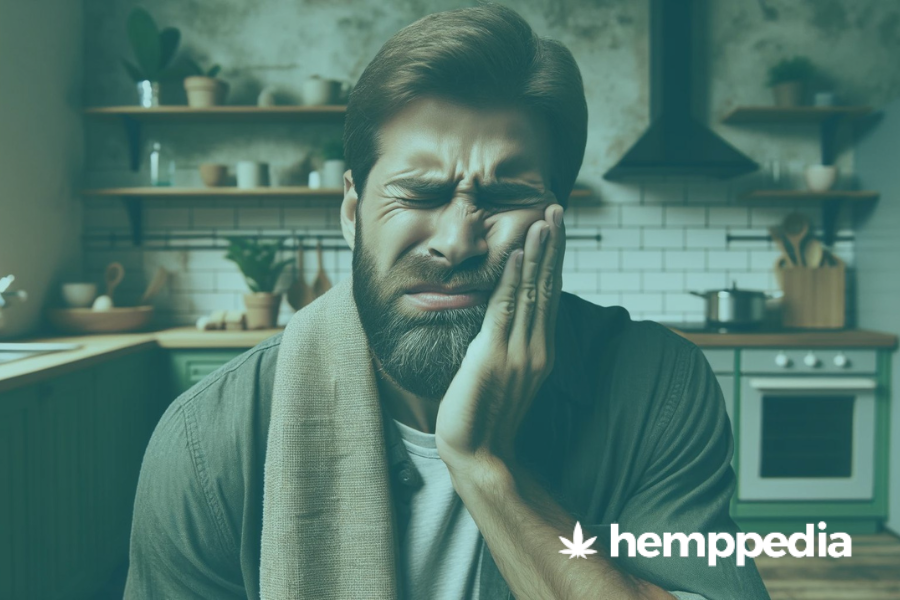What is a Migraine?
Why Does CBD Work for Treating Migraines?
Common treatments for migraines are pharmaceutical painkillers, anti-emetics (to stop nausea), or triptans (triggering the brain to reverse migraines). According to some studies, CBD can be a promising treatment1. CBD is made from the cannabis plant, which is known to have a reputation as a very powerful natural painkiller. Nonetheless, CBD has no intoxicating effect.
Migraines typically start in a part of the brain known as the hypothalamus. A migraine can be triggered as a response to extreme stress. Despite the cause, the majority of people suffering from migraines have the neurotransmitter serotonin in levels that are rather unbalanced.
Having serotonin in low levels might cause the dilation of blood vessels which increases the cases of migraine attacks. Cannabis has shown to increase the levels of serotonin by preventing dilation of the blood vessels2. Increased levels of serotonin will decrease the onset of migraine attacks.
Moreover, in another study published in the The Journal of Experimental Medicine,3 it is put forward that CBD serves as a painkiller for chronic pains, in general.
An explanation of how CBD actually works and fights the pain caused by migraines has been given by Dr. Ethan Russo in his theory of Clinical Endocannabinoid Deficiency4. This theory suggests that particular diseases are the cause of particular deficiencies in the endocannabinoid system. This is a biological system which functions as a responder to the types of cannabinoids called endocannabinoids, which naturally occur in the body, but could also be supplied by ingesting hemp product.
The deficiency of these biological endocannabinoids in one’s body may cause chronic pains, including migraines. According to the neurologist Russo, CBD regulates and triggers the receptors of the endocannabinoids system and eases the pain.
What are the Side Effects of Using CBD to Treat Migraines?
While CBD is generally considered safe, some people will experience some side effects. The side effects include nausea, diarrhea, drowsiness, change of appetite, and a dry mouth. The symptoms are rare, though, and not as severe as the ones caused by the conventional drugs used to treat migraines.
Vaping, similarly to every other product which requires inhaling, might be a cause of lung irritation and make you cough. Therefore, vaping is not recommended if you suffer from any lung disease. If you have never had problems with your lungs it most probably will be very safe. However, discuss with your doctor before deciding to vape and to use particular amounts of the CBD oil.
CBD Dosage for Migraines
For more details on dosage and microdose read our article on CBD dosage.
How Can I Use CBD to Treat Migraines?
Other methods of taking CBD oil is by vaping it. It can be taken using vaporizers or different inhalers. This method is one of the fastest and has an instant effect. It is recommended more if you have severe migraines so their pain will be relieved right away. However, do not vape if you have asthma or any other lung disease or if you are a beginner as it can be too much for your body at first due to its instant function.
CBD oil can also be directly applied to the skin since it comes as a lotion or balms, or creams. You can always try different ones and figure out which one works better and is easier to be used by you. It highly depends on your lifestyle and body.
What is Research Saying About Using CBD for Migraines?
Neuroscientists, such as Ross and Russo, have worked and continue to do so on showing the benefits of using CBD oil for migraines. Russo has explained its effects based on the Clinical Endocannabinoid Deficiency6 whereas Ross has used it herself to treat her migraine and is using her nonprofit to help in more researches and its legalization.
Moreover, the European Academy of Neurology, in summer 2017, published a study7 concluded that CBD oil had more effect than prescription drugs in decreasing the chronic migraines pain. In this study, there were 121 participants. After 1 month, a vast majority of 85% claimed that they had fewer migraines while they were on the study and were using CBD oil. Another study conducted by the researchers of Colorado found out that cannabis helps in easing the pain of migraines.
To sum up, there are multiple studies and proof by doctors and researchers that CBD is one of the best pain relievers, especially when it comes to chronic pain such as migraines. It increases the serotonin in the body of the taker and also triggers the receptors of the endocannabinoids system by thus easing the pain. It comes from the cannabis plant but it does not get you « high » since it does not have the component of cannabis which causes that, the THC.
CBD for Migraines – Customer Reviews
Totally in love 




« Fast shopping and amazing products. I am already in love. Headache and migraine?… Gone. Stress level?…much lower. My muscles and mind are finally calm. I recommend Nordicoil products with all my heart. »
Trustpilot review by J. M. Bak
After 45 years of migraines… 




« After 45 years of migraines, the attacks became worse with the onset of menopause. I had migraines every day for two years and only triptans helped. For three months I now take CBD capsules, two every morning with a sip of yogurt drink. And I can confirm that a sense of wellbeing has set in after a short time and that the migraine is now subsiding. Of course, I am not completely pain-free yet, but I have absolutely pain-free days again. I am convinced that the migraine will continue to disappear and I continue to take CBD. I can only recommend it. »
Trustpilot review by S. Schmitz
I am super satisfied 




« I am super satisfied, my migraine complaints have become significantly less and sometimes disappear completely. I can only recommend the oil with 5%! »
Trustpilot review by K. Oswald
References
- Greco, R., Gasperi, V., Maccarrone, M. and Tassorelli, C. (2010). The endocannabinoid system and migraine. Experimental Neurology, 224(1), pp.85-91. [↩]
- Aggarwal, M., Puri, V. and Puri, S. (2012). Serotonin and CGRP in Migraine. Annals of Neurosciences, 19(2). [↩]
- Xiong, W., Cui, T., Cheng, K., Yang, F., Chen, S., Willenbring, D., Guan, Y., Pan, H., Ren, K., Xu, Y. and Zhang, L. (2012). Cannabinoids suppress inflammatory and neuropathic pain by targeting α3 glycine receptors. The Journal of Experimental Medicine, 209(6), pp.1121-1134. [↩]
- Russo, Ethan B. „Clinical endocannabinoid deficiency reconsidered: current research supports the theory in migraine, fibromyalgia, irritable bowel, and other treatment-resistant syndromes.“ Cannabis and cannabinoid research 1.1 (2016): 154-165. [↩]
- Leinow,, L. and Birnbaum, J. (2017). CBD: A Patient’s Guide to Medicinal Cannabis. North Atlantic Books. [↩]
- Russo, Ethan B. „Clinical endocannabinoid deficiency reconsidered: current research supports the theory in migraine, fibromyalgia, irritable bowel, and other treatment-resistant syndromes.“ Cannabis and cannabinoid research 1.1 (2016): 154-165. [↩]
- National Academies of Sciences, Engineering, and Medicine. (2017). The health effects of cannabis and cannabinoids: The current state of evidence and recommendations for research. Washington, DC: The National Academies Presswhich [↩]




